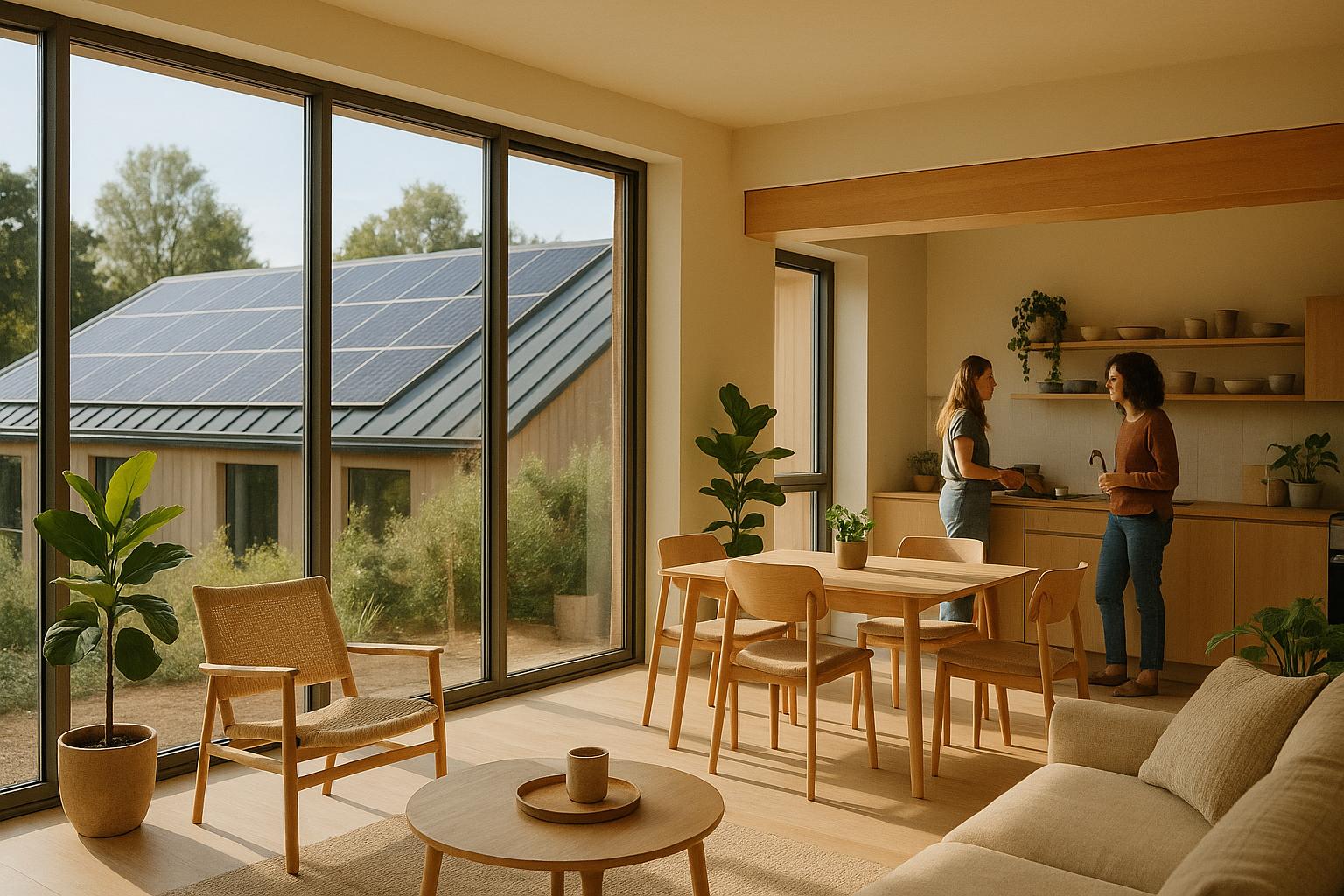America’s housing crisis is severe, with over 4.5 million homes in shortage, skyrocketing rents, and rising mortgage rates. Many people, especially young professionals, students, and remote workers, are struggling to afford traditional housing options. Coliving - a shared housing model where residents have private bedrooms but share common spaces - offers a potential solution by combining affordability, flexibility, and community.
Why Coliving Could Help:
- Affordable: Residents save 20–50% compared to traditional apartments. For example, coliving rents in NYC average $1,799, compared to $3,500 for a studio.
- Flexible: Short-term leases make it ideal for remote workers and digital nomads.
- Community-focused: Shared spaces and events reduce loneliness, with 71% of residents reporting they feel less isolated.
- Efficient Use of Space: Smaller private areas and shared amenities can house more people in urban spaces, reducing costs.
Challenges:
- Outdated zoning laws and restrictions on unrelated individuals living together hinder growth.
- Parking and density limits increase costs for developers.
Policy Solutions:
- Zoning reforms to recognize coliving as a distinct category.
- Incentives for converting underutilized spaces, like offices, into coliving units.
Coliving isn't a complete fix for the housing crisis but could play a significant role in creating more affordable and flexible housing options, especially in urban areas.
What is Coliving? A Modern Housing Model
Coliving has emerged as a fresh solution to the housing crisis, blending affordability with a sense of community. Unlike traditional apartment living, which can sometimes feel isolating, coliving focuses on fostering shared experiences. Residents enjoy private bedrooms while sharing common spaces, amenities, and resources, creating an intentional sense of connection.
This housing model strikes a balance between personal privacy and shared spaces designed for work, socializing, and relaxation. It’s an answer to the growing demand for affordable housing that doesn’t sacrifice human interaction.
In recent years, coliving has gained momentum, particularly among millennials and Gen Z. These generations often prioritize experiences and meaningful connections over owning property. They’re redefining what it means to live well, favoring flexibility and community over the solitude that often comes with traditional renting.
Coliving spaces are thoughtfully designed to prioritize comfort. Residents have private rooms and access to fully furnished communal areas. Unlike profit-driven rental models, coliving centers on creating a supportive environment for its tenants.
Key Features of Coliving
Coliving spaces typically offer all-inclusive pricing, covering utilities, Wi-Fi, cleaning, and access to shared amenities. These setups also provide flexible lease terms, which are perfect for people with changing work or lifestyle needs. Unlike conventional apartments that often require year-long commitments, coliving leases are designed with shorter terms in mind.
Fully furnished living spaces mean residents only need to bring personal items. Shared amenities often include features like co-working areas, fitness centers, rooftop gardens, meditation rooms, and sometimes even swimming pools.
When it comes to cost, coliving can be surprisingly budget-friendly. Residents often save between 20% and 50% compared to private apartments. In some cases, coliving can be up to 40% cheaper than renting a studio. Beyond financial savings, household responsibilities like cleaning and maintenance are shared, while professional management teams handle leasing and community events, making daily life easier and more enjoyable.
Who Benefits from Coliving?
Coliving is particularly appealing to those who value flexibility and social connection. One of the largest groups embracing this lifestyle is remote workers. As traditional office environments shift, many people working from home miss the networking and interaction that offices used to provide. Coliving bridges this gap by offering communal spaces that promote both productivity and social engagement.
Students and young professionals also find coliving a great option. It provides an affordable way to live in expensive urban areas while offering built-in social networks. This is especially helpful for those navigating tight budgets or early career transitions.
Digital nomads are another group drawn to coliving. For them, the community aspect is a welcome alternative to the isolation that can come with short-term rentals or hostels. Many coliving hubs now cater specifically to this group, offering flexible arrangements like day passes, weekly rates, or annual memberships.
One of the most impactful aspects of coliving is its ability to combat loneliness. According to the Flexible Living Trend Report 2024, 58% of coliving residents report forming close friendships, and 71% say they feel less lonely compared to living alone.
"Coliving spaces give renters the best of both worlds: they can join community events when they seek human connection and retreat to the comfort of their private rooms when they seek solitude." - The Citylifer
How Coliving Addresses the Housing Crisis
The housing crisis in America has made traditional housing increasingly out of reach, pushing people to explore new solutions like coliving. This concept not only cuts costs but also helps combat isolation, offering a practical and community-focused alternative in urban areas. By rethinking how space is used and shared, coliving provides a fresh approach to modern housing challenges.
Affordable Living Through Shared Resources
Coliving helps tackle skyrocketing housing costs by sharing expenses among residents. By pooling costs for rent, utilities, and amenities, people living in coliving spaces can save an average of 30% compared to traditional housing. For instance, in New York City, the average cost of a studio apartment is around $3,500 per month, while coliving spaces average $1,799. In Atlanta, the difference is just as stark, with coliving options starting at $719 compared to $1,714 for a typical one-bedroom apartment.
The savings don’t stop there. Many coliving spaces follow an all-inclusive pricing model, bundling rent, utilities, Wi-Fi, and cleaning services into one monthly fee. These spaces are often fully furnished and require little to no security deposit, significantly reducing upfront costs.
"The fact that these rents are 'all in' monthly costs (including water, electrical, furnishing, security, cleaning, and no move-in cost) make the product particularly attractive as compared to other low cost and market-rate product(s)." - Wes LeBlanc, Principal and Strategy Director, Gensler
Making Use of Underutilized Spaces
Coliving also tackles housing shortages by repurposing unused spaces, such as vacant office buildings, into vibrant residential communities. Converting offices into coliving spaces can slash development costs by 50–75% compared to new construction and by 25–35% compared to traditional office-to-apartment conversions. In downtown Chicago, for example, around 10% of office buildings are unsuitable for standard apartment conversions but work perfectly for coliving, which focuses on smaller private areas combined with larger shared spaces.
Coliving units are typically smaller - averaging 204 square feet compared to 366 square feet for studios and 775 square feet for traditional apartments. This efficient design allows more residents to live within the same urban footprint, reducing costs and maximizing space. A prime example is the ALTA development in Long Island City, where coliving units generate 44% more income per square foot than traditional apartments and achieve a 30% higher net operating income per square foot, even after factoring in housekeeping services. Beyond financial benefits, these spaces also foster social interaction and community building.
Building Community and Reducing Isolation
Coliving addresses another modern challenge: loneliness. Studies show that 20–43% of U.S. adults experience chronic loneliness. Coliving spaces are designed to encourage human connection, featuring shared kitchens, lounges, coworking areas, and rooftop spaces that naturally bring people together. Many coliving operators go a step further by hosting events like cooking classes and professional networking sessions, helping residents form meaningful relationships.
This shared living model also promotes sustainability. By centralizing appliances, furniture, and other resources, individuals can reduce their environmental footprint by about 23%. This approach not only supports eco-friendly living but also strengthens a sense of community.
"To come out of this generational housing crisis, we'll need to think differently. We need more product types and more price points. Right now, we're leaving hundreds of thousands of people without realistic housing options. Co-living is one way we can start to change that." - Wes LeBlanc, Principal and Analytics Director at Gensler
Examples of Successful Coliving Spaces
Coliving projects across the United States highlight how this housing model helps tackle urban housing challenges while building vibrant communities. These examples show the practical ways coliving is reshaping affordability and community living in cities.
Urban Coliving in Major US Cities
Tripalink in Chicago stands out as a model for scalable coliving. By August 2023, they managed 473 beds in the city, aiming to reach 1,000 by the end of the year. Their Post Chicago development, featuring 107 coliving units, offers rents starting at $1,375 per unit. What makes Tripalink different is their integration of AI-powered tools to simplify the housing search, paired with smart home features and hotel-like amenities that cater to tech-savvy tenants.
In Los Angeles, the 4981 Centinela project by Bittoni Architects showcases a creative design approach that balances affordability with community living. It includes compact private spaces alongside larger shared areas like kitchens, living spaces, and a rooftop deck with ocean views. Residents also benefit from shared amenities such as dining rooms, laundry facilities, and a recreation room. The design thoughtfully addresses urban issues like traffic noise while fostering a sense of community.
"Co-living can address this need by providing on-site management and security, and by offering shared amenities that foster community and social interaction while still providing residents with a sense of privacy." - Mark Bittoni, principal of Bittoni Architects
PadSplit offers another innovative approach by converting single-family homes into shared housing in cities like Houston and Jacksonville. In Houston, PadSplit units are priced at $667 per month, compared to over $1,000 for a traditional studio apartment. This setup saves renters an average of $332 monthly while also allowing property owners to increase rental income by repurposing existing spaces.
Coliving isn't limited to new developments - it also breathes life into underutilized buildings through adaptive reuse.
Adaptive Reuse Projects
Transforming underused buildings into coliving spaces has proven to be a creative way to address housing shortages while revitalizing urban areas.
In Newark, New Jersey, adaptive reuse projects are converting historic buildings into housing. The Walker House at 540 Broad Street, once the New Jersey Bell Telephone Company headquarters, is now home to 264 loft apartments with retail spaces on the ground floor. Similarly, 10 Park Place, the former Firemen's Insurance Company headquarters, is being turned into 231 affordable housing units, giving new life to a long-vacant structure.
"It's wonderful to see some of these larger vacant buildings being brought back to life. In a city like Newark, where we have lost so much of our historic fabric over the years, it's encouraging to see buildings that are not just standing as reminders of the past but finding a new purpose and contributing to the future." - Pallavi Shinde, AICP, PP, Newark's planning and zoning director
Texas has also embraced adaptive reuse. In Garland, Texas, the City Square Lofts project transformed a former Bank of America office into multifamily housing with the help of Low-Income Housing Tax Credits. Another example, the Draper project, repurposed a former Chase Bank into housing, supported by city grants to address asbestos removal.
One particularly inventive example is The Willows at East Greenville in Montgomery County, Pennsylvania. A former casket factory was converted into a 71-unit mixed-income development, funded by $11.66 million in Low-Income Housing Tax Credit equity and $3.36 million in Historic Tax Credit equity, among other sources, totaling $22.7 million. The project preserved the building's historical exterior while meeting zoning requirements for community standards.
In Los Angeles, Gensler estimates that converting office buildings into micro-apartments for coliving could reduce rents to around $1,000 per month, half the city’s median rent of $2,072. Similarly, in Houston, micro-units could cost $700 monthly, compared to the median rent of $1,297. These projects also cut construction costs by 25% to 35% compared to traditional office-to-residential conversions.
"The fact that about three times as many units per floor can be created with co-living also means the impacts on both downtown revitalization and the housing shortage are much bigger." - Alex Horowitz, Project Director, Housing Policy Initiative, The Pew Charitable Trusts
These examples show that coliving isn't just an idea on paper - it’s a practical, effective solution already making housing more affordable and accessible while revitalizing underused spaces across the country.
Challenges and Policy Recommendations for Scaling Coliving
While coliving offers potential as a housing solution, it faces hurdles due to outdated zoning laws and regulations.
Regulatory and Legal Barriers
One of the biggest challenges for coliving is zoning laws, which often fail to accommodate these unique living arrangements. Coliving spaces don’t align neatly with traditional residential, commercial, or mixed-use categories. Many local governments also impose limits on the number of unrelated individuals who can live together, directly clashing with the coliving model. Take Shawnee, Kansas, for example: the city council passed an ordinance banning four or more unrelated adults from living in the same home. This "co-living ban" emerged even as rents in nearby Johnson County jumped 13.3% between 2019 and 2022, prompting the Pacific Legal Foundation to file a federal lawsuit, arguing the ordinance unfairly restricts personal living choices.
"Coliving: An Old Idea Is New Again, modern coliving facilities, where a group of four to eight residents occupy a partially or fully furnished unit with private bedrooms and shared living spaces, are in many ways a throwback to the first half of the 20th century when boarding houses were commonplace in many cities."
– Kelly Cousino, AICP
Other zoning issues, like low-density limits and strict parking requirements, further complicate coliving projects. These rules reduce how many people can live in a space and drive up costs, making it harder for developers to move forward. The result? A chilling effect on investment in this much-needed housing option.
Addressing these regulatory barriers is key to making coliving a viable and scalable housing solution.
Policy Changes to Encourage Coliving Growth
Smart policy reforms could unlock coliving’s ability to expand housing options and lower costs, as research from Gensler and The Pew Charitable Trusts suggests.
Financial incentives are one way to make coliving more attractive. For instance, coliving spaces in Los Angeles can offer micro-apartments for around $1,000 per month, roughly half the city’s median rent of $2,072. Similarly, in Houston, coliving rents could drop to $700 per month, compared to the city’s median rent of $1,297. Subsidies also stretch further with coliving: in Los Angeles, micro-units might need about $120,000 in subsidies per unit, compared to $380,000 for a traditional studio apartment.
"In each city we've studied, local governments could create far more housing with their subsidy dollars using this model than with conventional apartments."
– Alex Horowitz, Project Director, Housing Policy Initiative, The Pew Charitable Trusts
The numbers speak for themselves. In Denver, $100 million in subsidies could fund either 330 new studio apartments or an impressive 4,300 office-to-coliving conversion units, delivering over 13 times more housing from the same investment.
Zoning reforms also hold promise. Cities could formally recognize "coliving communities" as a specific category and adjust density and parking standards accordingly. For example, instead of counting "dwelling units", zoning could focus on the number of bedrooms to better represent occupancy. Developers could also use demand studies to justify reduced parking requirements, further cutting costs.
Recent policy changes hint at what’s possible. On December 5, 2024, New York City Council passed the "City of Yes for Housing Opportunity" plan, which eliminates parking mandates, promotes office-to-residential conversions, and encourages higher-density development. This initiative could lead to 80,000 new homes over the next 15 years and dedicates up to $5 billion for housing and infrastructure projects.
Office-to-coliving conversions stand out as a particularly effective strategy. With office vacancy rates hitting a record 20% - leaving over a billion square feet of unused space - these conversions could address housing shortages while revitalizing urban areas. They’re also cost-effective, cutting construction expenses by 25% to 35% compared to traditional office-to-residential projects. Plus, coliving can create about three times as many units per floor as standard apartments, offering a much-needed boost in housing supply. Public subsidies can further encourage developers, especially since coliving properties often deliver 20% to 30% higher yields due to their greater tenant density.
To make these projects successful, early collaboration with planning authorities and clear, updated development guidelines are critical. With the U.S. facing a housing shortfall of 4 million to 7 million homes and coliving projected to grow at a 6.75% annual rate from 2024 to 2033, targeted policy changes could turn coliving into a mainstream solution for the housing crisis. These reforms not only pave the way for new housing models but also tackle America’s pressing need for affordable homes.
Conclusion: Is Coliving the Answer?
Coliving has emerged as a promising, though not all-encompassing, solution to America's housing challenges. With the global coliving market projected to grow from $7.7 billion in 2024 to $32.3 billion by 2034, it's clear this model is gaining traction.
Coliving addresses the housing crisis in three impactful ways. First, it offers affordability, with residents typically saving between 20% and 50% compared to traditional housing options. Second, it aligns with modern lifestyle needs by providing flexible, short-term leases - a perfect fit for today’s mobile workforce. This is especially appealing to the 72% of coliving residents aged 26–40, many of whom prioritize career mobility and flexibility. Remote workers and digital nomads, in particular, benefit from this adaptability in an ever-evolving job market.
Perhaps the most compelling aspect of coliving is its ability to combat social isolation. Through shared spaces and organized events, residents can forge meaningful connections, making it an attractive option for newcomers and young professionals looking to expand their networks.
The model also has immense growth potential, especially through adaptive reuse projects, which transform underutilized spaces into thriving residential communities.
However, coliving is not without its challenges. Outdated zoning laws and regulatory barriers must be addressed for the model to reach its full potential. While it won’t solve the housing crisis on its own, coliving represents a vital piece of the puzzle. For those seeking affordable, flexible, and community-focused housing, it offers a forward-thinking alternative that aligns with the demands of modern urban living.
The real question isn’t whether coliving can solve the entire housing crisis - it’s whether we’re ready to embrace this innovative approach as part of a broader strategy to create more accessible and affordable housing for all. With the industry expected to grow at an annual rate of 6.75% through 2033, coliving is well-positioned to play a significant role in shaping the future of housing in America.
FAQs
How does coliving compare to traditional housing when it comes to cost and flexibility?
Coliving presents itself as a cost-effective and adaptable alternative to traditional housing. Typically, coliving spaces are 20% to 50% cheaper, which makes them especially attractive in cities where housing expenses tend to be sky-high. This affordability comes from bundling utilities, amenities, and shared spaces into one convenient, all-inclusive price.
Another major perk is the flexibility in lease terms. Unlike traditional rentals that often demand long-term commitments, coliving spaces usually offer shorter, more adaptable agreements. This makes them ideal for remote workers, frequent movers, or anyone looking for a more adjustable living setup. Coliving provides a modern, budget-friendly lifestyle designed to fit today’s dynamic needs.
What are the biggest legal challenges for coliving in the U.S., and how can they be resolved?
Coliving in the U.S. comes with its share of legal challenges, particularly when it comes to zoning laws, tenant rights, and local housing rules. Many cities have zoning codes that limit the number of unrelated individuals who can live together in a single residence. This makes it tough for coliving spaces to fit within these restrictions. On top of that, developers often face a maze of local regulations that can be both complicated and time-consuming to navigate.
To tackle these obstacles, policymakers and housing advocates are pushing for updates to zoning laws to better reflect modern shared housing models. States like Colorado and Washington have already taken steps to introduce reforms aimed at making coliving a viable option to address housing shortages. By revising outdated rules, cities can pave the way for coliving spaces to thrive, offering more affordable and accessible housing options.
How does coliving help reduce social isolation, and what features encourage community connections?
Coliving offers a solution to the growing issue of social isolation by creating spaces designed for connection and community. These living arrangements make it easier for residents to form relationships and enjoy meaningful interactions, thanks to their focus on shared experiences and communal living.
Some of the standout features include shared amenities like kitchens, co-working spaces, fitness centers, and living rooms, which naturally bring people together. Many coliving spaces also organize events - think group dinners, workshops, or game nights - that encourage residents to socialize and bond. On top of that, community managers often play a key role in fostering a warm, welcoming environment by introducing residents to one another and ensuring everyone feels included. Together, these features create a supportive atmosphere where people can thrive and feel a true sense of belonging.






